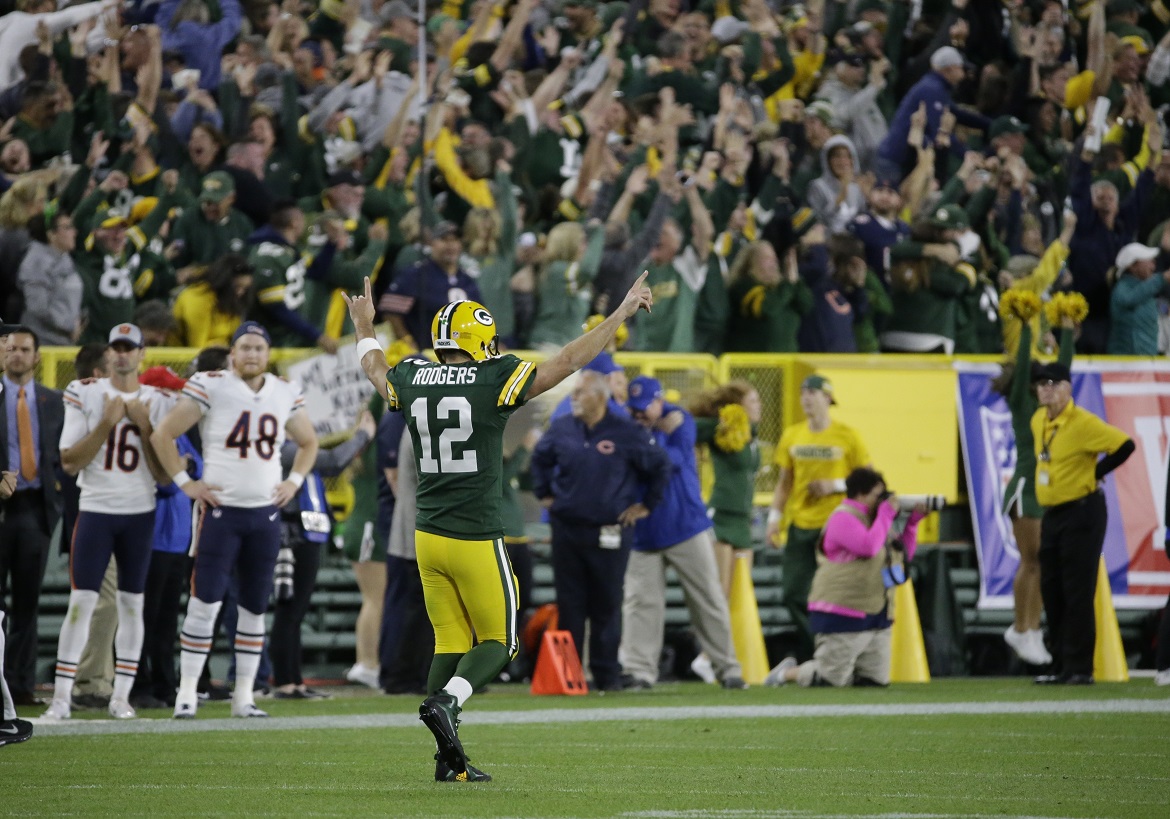
Michele Tafoya stood next to Aaron Rodgers on the Lambeau Field turf and saw the mischievous glint in the quarterback’s eyes. She knew a good interview was ahead.
And it was, with Rodgers not only reveling in the comeback he’d led on NBC’s first Sunday night telecast this season, but guaranteeing his knee problems would not sideline him for the next game against Minnesota.
It was a short conversation that highlighted how a sideline reporter — perhaps the most thankless job in sports broadcasting — can bring news and some entertainment to the viewer.
Aaron Rodgers’ post-game interview with Michele Tafoya is an absolute must-see. Emotional about the injury and elated about the comeback. It’s impossible not to be a fan. #CHIvsGB pic.twitter.com/aJSmKJeLja
— Rob Lowder (@Rob_Lowder) September 10, 2018
That’s something Tafoya has been doing for three outlets: NBC, ABC and ESPN. She worked her 250th game when the Cowboys beat the Giants in Week 2 of the NFL schedule.
“The other night with Aaron, you could feel the air leave that building when he was hurt,” Tafoya says. “Are you kidding me? The thought occurred he might be done, and he was done early last year, too. And then to witness the comeback, it was sort of like watching a movie.
“When he came back on the field and he was on the sideline, Mike McCarthy was saying, ‘We will see if he is ready.’ Aaron was smiling and had that gleam, and there’s nothing like that when it’s in his eyes, when he has that little mystery in him. Then to see he was so ticked when they had to settle for a field goal on his first drive back, he was livid.
“Then the gleam came back, and I thought about it throughout that performance — and you are standing right there; my eyes were on this guy even if the camera couldn’t be.'”
As for the comeback to beat the Bears, which didn’t surprise Tafoya at all because she’s seen it so many times from the Packers star, “He knew it. He has an uncanny ability to focus and seem to be relaxed in the process.”
There are so many inherent difficulties in the sideline reporters’ jobs. The last thing they want to be is superfluous, yet nuggets of knowledge aren’t always available. Pro sports teams aren’t all that forthcoming with any information, let alone injuries or benchings.
By necessity, the time Tafoya and her peers have on the air is limited; fans tune in for the action on the field, not for who is announcing. It’s a get in and get out sort of environment, so being concise and precise are essential.
“The No. 1 job for any broadcaster is ‘getting it right.’ Michele embraces that responsibility and works extremely hard to fulfill it,” says Fred Gaudelli, executive producer for “Sunday Night Football.”
“A top-level sideline reporter needs to excel in a few areas. No. 1, they should be a reporter first, and possess the skills that go with that job. Second, they have to be versatile and understand tone. Versatile in the sense that they are equally effective in telling a personal story or reporting on a serious matter. Tone in the sense that their delivery fits the story.
“And lastly, they must be fast on their feet in what’s often a chaotic environment. Things change quickly and they must be able to absorb the changes and report them effectively. Michelle gets an A-plus in all those categories.”
Probably her most challenging work came when then-Texans coach Gary Kubiak collapsed just before halftime of a Sunday night game in 2013. The coach was wheeled into the locker room on a stretcher, but there was very little information immediately available on his condition.
Tafoya did what any professional reporter should do, sticking to what she knew.
“The Houston head coach collapsed and no one saw exactly when it happened,” Tafoya reported. “It happened on or near the 20 (yard line), which appeared to be when he was walking off the field. He was attended, surrounded by medical staff. He was speaking, but he also looked to be in extraordinary pain. He could not open his eyes. …
“It appeared again that he tried to sit up momentarily, could not stay up. They laid him back down. I never once saw him open his eyes, but we did confirm that he was talking as he was wheeled off the field. A situation that we are going to continue to follow. Very frightening down here.”
Tafoya stayed with the story even as the game continued. She spoke with defensive coordinator Wade Phillips, who took over Kubiak’s duties for the second half, and told her audience what Phillips had been told by the medical staff:
“Now, what he was told was that this trip to the hospital in the ambulance is purely precautionary for Gary Kubiak, that his heart rate was fine, that his pulse was fine, again, it’s precautionary. This is what Wade Phillips told me. He said, ‘You know, with coaching, it could be that he’s just spent too many nights staying up all night and it’s finally caught up with him.'”
Tafoya made it clear to her audience that there was no official word from the team. When that word did come, she made sure to interview Texans general manager Rick Smith, providing firsthand knowledge to viewers.
Again, precisely the right journalistic approach.
“I am most proud of the Kubiak situation,” she says. “We had to very measured and it is difficult to remain in that state when you are dealing with a situation that could go very badly in an instance. I worked every angle I possibly could in the confines of that stadium. I am very proud of that work.”
















